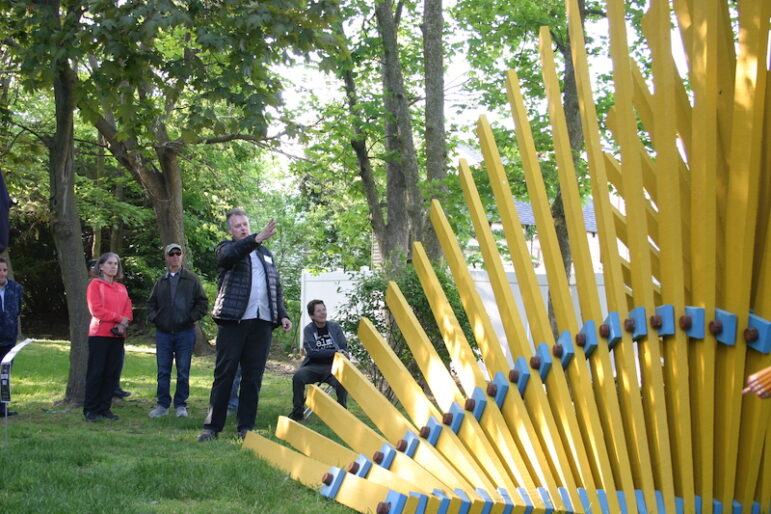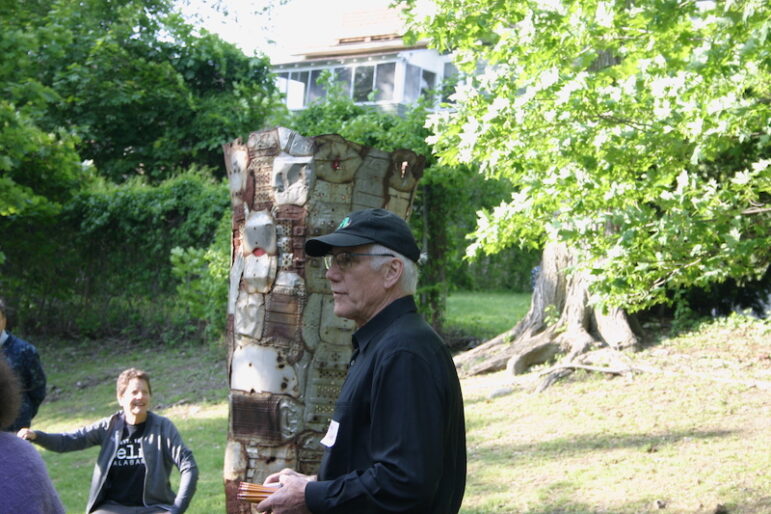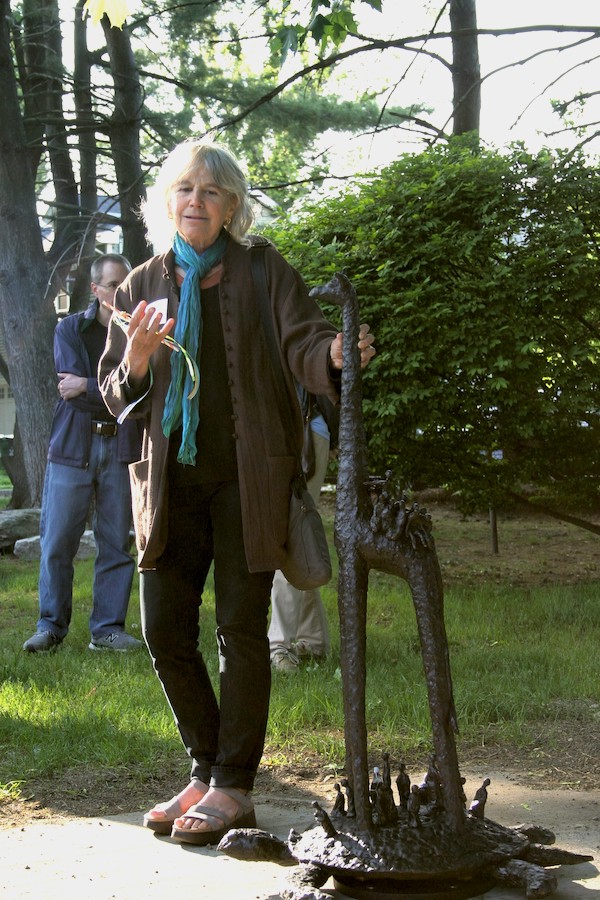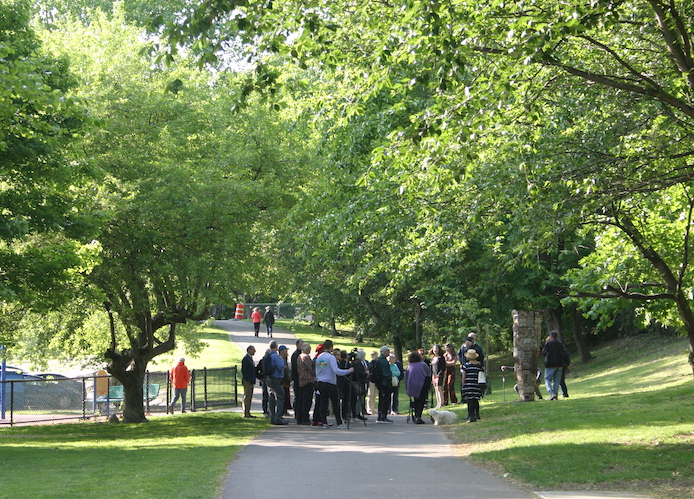
Anaïs Markwood Artist James Payne speaks about his sculpture “Opposition” during the grand opening of the Community Sculpture Walk.
As of May 18th, Watertown is home to four new sculptures! The new Community Sculpture Walk in Watertown Square had its grand opening, unveiling a series of four sculptures located along the Community Path that runs behind Saltonstall Park.
The sculptures, each created by New England-based artists, are located incrementally along the path, stretching from the edge of the parking lot behind the Watertown Free Public Library (WFPL) down the path towards Waverley Avenue, with the farthest sculpture sitting by the section of the path near Chulo Restaurant and Bar.
The sculpture walk was organized and put together by the Watertown Public Arts and Culture Committee (WPACC) and spearheaded by Liz Helfer, Watertown’s Public Arts & Culture Planner. Helfer, who noticed sculpture walks popping up in many surrounding communities, had been hoping to have one in Watertown for years.
“I pitched the idea to the Public Arts & Culture Committee in January 2022,” said Helfer, “and the Community Sculpture Walk officially opened on May 18, 2023 – a tight turnaround!”
As for the location, choosing the Community Path in Watertown Square was not a random choice.
“Because the Community Path is a central bike/pedestrian corridor and will see even heavier traffic due to the temporary high school location at Moxley Field, highlighting the corridor through contemporary sculpture felt timely,” said Helfer.
Once the project was a go, the WPACC sent out the call for artists, working in tandem with the New England Sculptors Association to get the word out to local creators. The project received 40 applicants, which they then narrowed down to the four seen in the park today. During the review process, each member of the WPACC scored the sculptures based on safety, merit, and relevance to the inaugural theme “the river.” The four chosen artists were compensated with $2,000 each for their contributions. However, the other 36 applicants may yet get a chance to show their work on the Sculpture Walk as the sculptures are planned to be switched out with new ones every two years. This way, the contemporary art will remain truly contemporary and Watertown’s Sculpture Walk will be an ever-changing art gallery.
Anaïs Markwood
Joe Chirchirillo discusses his piece “Power Plant,” one of four sculptures in Watertown’s new public art display.
At the grand opening last week, Watertown citizens gathered to see the new art and to hear each of the artists speak about their work. The event began by the first sculpture, near the library parking lot, where Helfer introduced the project along with another member of the WPACC. Then the group moved down the line of sculptures, stopping to hear the artists speak in front of their respective pieces along the path.
Beginning where the path meets the library’s parking lot, the first sculpture is Joe Chirchirillo’s “Power Plant.” The piece is made of pigmented cast concrete and was first created by Chirchirillo in 2017 after a family trip to Joshua Tree National Park in California. Chirchirillo was inspired by the trip and wanted to create something that captured Joshua Tree as well as, more generally, the juxtaposition between nature and industry. He explained that much of his work follows this theme and described “Power Plant” as “highly mechanical [but] also highly organic.” As for how this piece fits the inaugural theme of “the river,” Chirchirillo talked about Watertown’s history as a mill town powered by water wheels, of which the shapes of “Power Plant” are reminiscent.
“Things were driven by water,” he said. “This is called ‘Power Plant’ like an organic plant but also a machine.”
Chirchirillo himself resides in North Bennington, Vermont and has been sculpting since the 1970s, when he began making clay sculptures in his bedroom in high school.
Heading towards Waverly Avenue, the next is Peter Dellert’s “Inheritance.” This striking piece is made of catalytic converter covers on welded steel armature. Dellert found each converter cover by the side of the road over a span of 10-15 years, meaning that each piece is unique and recycled, as he pointed out.
“The major statement,” said Dellert, “is that it’s a natural form … And it’s made with man-made material. This juxtaposition is really interesting to me.”
Anaïs Markwood
“Inheritance” by Peter Dellert is made of catalytic converter covers found on the roadside.
As for the title of the piece, Dellert stressed the importance of recognizing that we are inheriting the legacy of the industrial revolution. “This piece is about ecology,” he said. Dellert lives and works in Holyoke.
Next on the path is James Payne’s “Opposition.” This piece is made of painted wooden beams, each of which is sourced locally from near where Payne lives in Perkinsville, Vermont. The colors of the sculpture, yellow, blue, and red, represent the colors of the Romanian flag. Payne travels to Romania every year and wanted to include this in his work.
As for the title, “Opposition,” Payne explained, “Ordinarily, my works are spirals, but this one spirals but comes back, so that’s where the title came from.”
Payne also explained how he hopes his sculpture will be engaged with, saying, “This is large scale art, it’s meant to be walked around…It’s different from every angle.”
He connected his piece to the theme of “the river” by noting that “it feels like it belongs in water,” and he hopes that Watertown residents will engage with and enjoy his artwork.
The last of the four pieces is Linda Hoffman’s “Refuge,” which is made of cast bronze, and is the only of the four pieces that isn’t abstract. Hoffman’s piece depicts a giraffe standing on the back of a turtle, with a cluster of tiny humans underneath its stomach.
Hoffman talked about the close ties her sculpture has to ecology, saying, “This young giraffe and the sea turtle are both endangered species — they’re from South Africa — and they know that it is us who have destroyed their habitats but they are willing to rescue us … They are offering refuge.”
As for how the piece fits the year’s theme, Hoffman talked about how water connects people and animals together across the globe.
“I was really feeling that water connects us all and water is so important,” she said. “It can be from as far as the tip of South Africa or falling as rainwater.”
Anaïs Markwood
Linda Hoffman next to her sculpture “Refuge,” which is on display along the Community Path between the Watertown Library parking lot and Waverley Avenue.
Hoffman hopes that her sculpture brings “delight” to passersby on the Community Path.
“I hope it raises the question of why are there people on there and what are they doing,” she said.
She also noted that it could appeal to different age groups: “adults might think of refugees, while children will see humanity and enjoy the tactile surface,” she said. Hoffman’s work is done at the Mission Foundry in Woburn.
Community members enjoyed walking along the path and hearing each artist talk, asking questions and taking photos along the way.
“I think (the Sculpture Walk) is great,” said Vicky Sax, a Watertown resident. “I think the arts are growing and a strong arts presence makes a strong community.”
Anaïs Markwood
Residents joined the artists during a tour of the Community Sculpture Path on May 18.
Helfer seemed very happy with how the project turned out, noting her own personal connection to 3D art.
“Outside of my work for the City, I am a sculptor, and I find three-dimensional artwork compelling for how it relates to our special awareness and our own bodies. Large outdoor sculptures, like those that can be seen along the Community Path, are wonderful for their scale and materiality,” she said. “I love that each sculpture is a different material, is very tactile, and can make you question how it was made. The Community Sculpture Walk in particular, puts art where those who might not seek it out will find it.”
She added, “I hope it will be a pleasant discovery and provoke reflection, as art often evokes feelings and new patterns of thought. Because new sculptures will be rotated into the CSW each year, we will continue to build opportunities to discover new art and create new opportunities for artists.”
As noted, this cohort of sculptures will be up for two years, so Watertown residents will have many opportunities to go visit them. Each sculpture is accompanied by a plaque describing the piece and a QR code linking to a short speech by the artist. Visit the Community Sculpture Walk to see these pieces in person and to learn more!